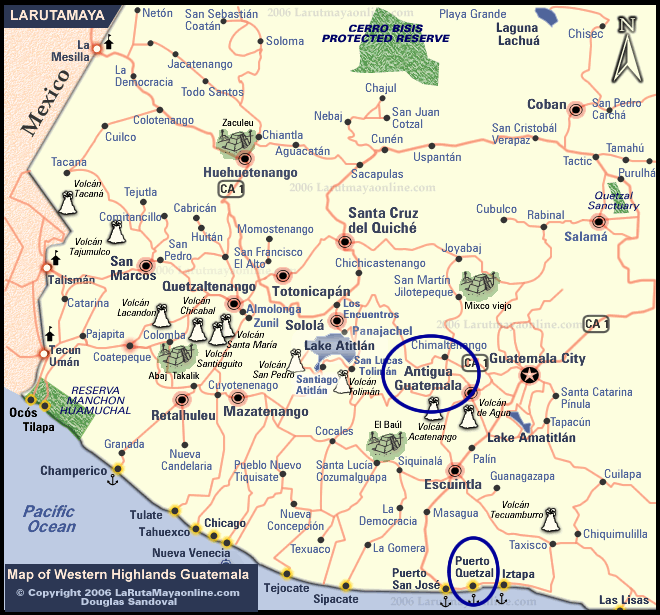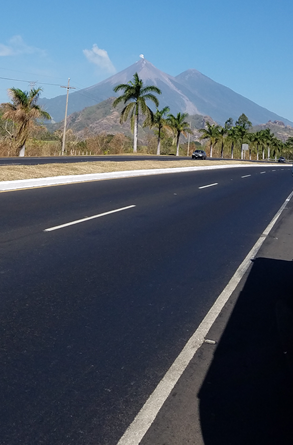Guatemala (January 13, 2017)

Like Nicaragua, with the exception of Antigua which is an hour away from the main port, Guatemala is not set up for tourism . Antigua is a UNESCO heritage site and was one of the first (1979). All streets are cobblestone and must stay that way. The sidewalks are fairly narrow and have bars around protruding windows. These hazards plus occassional large holes in the sidewalk make walking hazardous.
Like all cities organized by the Spanish there is a large park in the center which is very pleasant. At an altitude of 5000 feet the temperature here was very pleasant after two days of 90+ temps. Many cathedrals for a relatively small city, some in disrepair.
The town square was full of Mayans all selling serapes, table runners, beaded jewelry, a long wooden "flute" and small drums, and oh yes, a few masks. They were not as aggressive as in some countries, and eventually would take ,"Gracias, no" for an answer.
The small children are running around everywhere with what, to us, seemed like no concern for their safety. Yet they were perfectly safe. In one part of the park young preschool boys and girls were chasing the pigeons with much laughter.
There are 37 volcanoes in Guatemala, three of which are active. Although there was not a lava spill while we were there, (there was one 2 weeks ago), 
Fuego was showing off and emitted puffs of smoke regularly, some quite large. These puffs all became what looked like cumulus clouds. The natives believe that this periodic smoking helps to relieve the pressure as do the small earthquakes. The worst smoke, however, came from the coast where they wereburning of the sugar cane fields prior to harvesting.
Like the other Central American countries which we visited there is a rainy season (June to about November). In rainy season the sun is generally out in the morning and in the afternoon there are heavy showers.
The drug trade is the largest source of income with serious violence being confined to those in that "industry." All other crime is what is called "incidental," as in you leave a camera in a locked car and the window is broken etc. and pick pocketing. To prevent this the square in Antigua had many policemen.

The second source of income is remittances sent from the US. Then comes agricultural products. Coffee is very big here. I did not realize that coffee is grown under trees - the ones they choose have deep roots and do not compete with the coffee plants for water, but provide shade. Like a live oak, they lose leaves all the time creating a mulch which fertilizes the coffee plants. The beans are picked by hand and the school year is set up to accommodate this. It starts in January and lets out in October so entire families can pick the beans which must be processed within24 hours after picking and picked at the height of ripeness. After about 5 years the coffee plant is cut back, but then grows again. One plant can last for almost a century.
Picking the sugar cane is more arduous than picking coffee beans and no women are employed. But as with the coffee the workers are migrant, mostly from the Maya areas. In prior times, father picked the cane and mother and the kids came to keep house for him. Today, the large sugar cane field owners house and feed the workers and Mom stays home. Today they were harvesting the cane which has to be processed within 36 hours of picking.
The economical mode of transportation throughout the country is on a "chicken bus" into which are often packed many people and sometimes chickens as well as riders on the top. Fares are low, and these are privately owned. The owners decide what routes they will operate. They are converted school buses that the United States has delared too old for service. In shops along the road we saw them stripped down to nothing but the structure. Then they are redone with 3 seats on both sides and decorated with many different colors. They are also seen in Guatemala and Honduras.

Sorry that is the best picture I could get and it does not show the pretty colors!
The Mayans, who make up 50% of the population keep to themselves in their own communities and intermarriage is rare. There are 17 different Mayan dialects most of which are not even remotely related. The public schools are bilingual with instruction moving from the dialect of the area to Spanish as the grades progress. (Private schools in the urban areas that are bilingual go from Spanish to English.) Although the law requires children to be in school from 6 to 16 it is not enforced. Many families, once the child is "literate," take him or her out of school to help earn money. In fact, most laws are flouted.
The income tax laws are not as complicated as ours, but the loop hole are many and few pay their legal amount. The country has Germans working with them to try and get a handle on this problem. The Germans finally told them that either they will follow their suggestions or they are done trying to help. The outcome should be interesting.